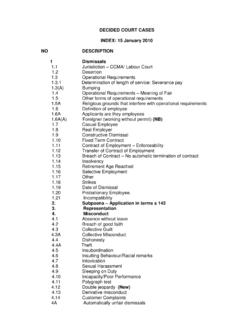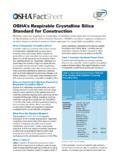Transcription of INDIANA LIMESTONE INSTITUTE OF AMERICA, INC. - …
1 The INDIANA LIMESTONE INSTITUTE wishes to thank the Natural Stone Council for its generous grant, which was used to print this Handbook and to make it available for downloading from our website. TM. INDIANA LIMESTONE INSTITUTE OF america , INC. STONE CITY BANK BLDG. #400. BEDFORD, IN 47421. 812-275-4426. FAX 812-279-8682. Web Page The INDIANA LIMESTONE INSTITUTE and its member companies will help users with any technical or aesthetic problem. We invite re- quests for assistance and will call on interested parties on request. The publication of this Handbook is made possible in no small part by the efforts of the ILI Technical Committee which is com- prised of engineers, design specialists and other interested industry personnel. The Committee meets regularly to evaluate technical inquiries regarding INDIANA LIMESTONE and to conduct an on-going review of the Handbook and other ILI publications. As a result this Handbook is supplemented from time to time with technical papers and informational brochures.
2 OTHER ILI LITERATURE AVAILABLE UPON REQUEST. The Finishing Touch How To Avoid Small Area Stains and Blemishes Preassembled Systems Repair Booklet Contractor's Handbook Specification Booklet Job-Site Folder Case History Series The Advantage of INDIANA LIMESTONE ILI Technote Series Use and Overuse of Testing in Specifying Dimension LIMESTONE Damage and Repair Practices and Standards Galvanic Action in Typical INDIANA LIMESTONE Connections Wood & Steel Stud Construction Safety Factors Grouted Cavity Walls Expansion Bolts for Anchoring INDIANA LIMESTONE Cleaning INDIANA LIMESTONE Panel Sizes in INDIANA LIMESTONE Usage Water Repellents Durability and Weathering in Contemporary Atmospheres Stone Handling Lifting with Lewis Pins Anchors and Supports Joint Sealants for INDIANA LIMESTONE Recommended INDIANA LIMESTONE Wall Heights Hand Rails and Posts CREDITS: Architects whose work is detailed in the Case History section CSO Schenkel Shultz Architects James Ingo Freed of Pei Cobb Freed G.
3 Cabell Childress, FAIA University of Denver Mackey Mitchell Associates Architects & Partners Architect Emeritus Pei Cobb Freed & Partners Cary Schafer Designs Hardy Holzman Pfeiffer Associates Fentress & Associates, Kohn Pedersen Fox Associates, Morris Architects Hanbury Evans Wright Vlattas & Company Ratio Architects, Inc. Tigerman Fugman McCurry Architects Shepley Bullfinch Venturi Scott Brown and Associates Geddes, Brecher, Qualls, Cunningham Architects SMBW Architects Anderson Mason Dale Architects Bohlin-Powell-Larkin-Cywinski Architects OWP&P Architects Burt Hill Kosar Rittelmann Associates Mark E. Rodgers, AIA University of Denver Notter, Finegold & Alexander, Inc. Bauhs & Dring Architects and Planners Architect Brubaker/Brandt, Inc. Shepherd & Partners Rysavy & Rysavy Moody/Nolan, Ltd. John Burgee Architects with Phillip Howard Needles Tammen & Bergendoff Barganier, McKee & Sims Johnson Hartman-Cox Architects Hnedak-Bobo Group Cooler, Schubert & Assoc.
4 , Inc. Lorenz, Williams, Lively & Likens Hardwicke Associates Inc. Lawrence Halprin & Associates Alvord Burdick & Howson Engineers Desmond, Miremont, Burks Edward Larrabee Barnes Associates Skidmore, Owings and Merrill NMT/Walk Jones & Francis Mah Browning Day Pollak Assoc., Inc. Copyright 2007 INDIANA LIMESTONE INSTITUTE purpose of the INSTITUTE ILI serves the construction industry, the architectural profession and the LIMESTONE industry as a coordinating agency for the dissemina- tion of accurate, unbiased information on LIMESTONE standards, rec- ommended practices, grades, colors, finishes, and all technical data required for specifying, detailing, fabricating and erecting INDIANA LIMESTONE . service to architects Help in the use of INDIANA LIMESTONE is available to architects, de- signers and specifiers in the selection of grade, color and finish. We offer a Review and Comment Service for preliminary drawings to help assure compliance with industry practice and to suggest details and treatments for the best and least expensive use of the material.
5 ILI will aid in soliciting budget and preliminary costing from its member companies. ILI will assist architects, contractors and build- ing owners in solving design problems and in all questions relating to best usage, maintenance and other matters of interest to users. Permission to copy, or otherwise use information, charts, graphs, diagrams, and other material appearing herein, which have been pre- pared by the INDIANA LIMESTONE INSTITUTE , its members or predecessors is routinely granted for the purpose of architectural construction speci- fications or other purposes directed and related to the use of INDIANA LIMESTONE for building. Information, charts, graphs, diagrams, and other material prepared by sources other than ILI, its members or predecessors may be restricted. Potential users of any material con- tained herein are urged to contact ILI regarding permission to publish or otherwise make use of these materials.
6 Extreme care has been taken in the preparation and presentation of all data and other information in the INDIANA LIMESTONE Handbook. ILI and its Technical Committees have made all reasonable efforts to insure that the information herein is accurate, and that any inferences based upon it are founded in conservative engineering and good testing prac- tices. However, proper design and construction practice includes con- sideration of many factors and variables, and it is the province and responsibility of the designer and the builder to evaluate the proper application of the data and information herein to specific building or other construction projects. ILI and its committees do not prepare plans or specifications or engage in engineering calculations relating this data to specific projects and accordingly disclaim any liability or responsibility for any errors, oversights or omissions in the use of this Handbook material or in the preparation of plans, specifications or calculations in reliance of this Handbook.
7 1. contents SECTION I .. page 3. general information SECTION II .. page 12. recommended standards and practices SECTION III .. page 47. product use SECTION IV .. page 84. case histories SECTION page 125. specifications, technotes, glossary, index 2. SECTION I. general information A Brief History of the INDIANA LIMESTONE Industry 04. Geological Formation 05. Chemical Analysis 06. Product Description 06. Seasoned Stone 07. Natural Bed 07. Physical Properties, Performance Tables, and Performance Characteristics 07-10. Classification of INDIANA LIMESTONE (Grading) 10. Staining and Efflorescence 11. 3. A brief history of the bridge piers and for the increasingly grandiose termi- nals in the growing cities. INDIANA LIMESTONE industry During this period, gang saws were introduced to Even prior to INDIANA 's admission to the Union in 1816, replace the two-man crosscut saws previously used to a light-colored, fine-grained native stone had been saw block stone into slabs; the introduction of the used by pioneer settlers for cabin foundations, door channeling machine to the quarrying operation en- sills, milling burrs, and memorials.
8 The stone was quar- abled the infant industry to double and triple production ried with use of long star drills and wedges to separate in succeeding years. blocks from the main deposit. The first organized quar- rying effort of record was established in 1827 in south- Extensive fires in the cities of Chicago (1871) and ern INDIANA near Stinesville. Boston (1872) added to INDIANA LIMESTONE 's demand. It was apparent that of all of the commonly used materi- Concurrent with the arrival of both north-south and als, masonry showed the least fire damage, and lime- east-west railroads into southern INDIANA in the mid- stone least of all. 19th century, the market for INDIANA LIMESTONE re- sponded to architectural demand for stone of a light- INDIANA stonework won awards of merit for quality at neutral color to complement the various Revival styles both the Philadelphia and New Orleans Centennial Expo- of the era.
9 The railroads themselves required stone for sitions of 1876. Contracts for INDIANA LIMESTONE in two major public buildings in that decade, the INDIANA Statehouse and the Chicago City Hall, established its reputation of superior weather resistance, ease of shaping, consistent quality, boundless supply and good public and architectural acceptance. In the final decades of the 19th century, INDIANA LIMESTONE was chosen for an increasing number of city halls, statehouses and federal office buildings. To meet the demand for stone, the number of quarries doubled between the years of 1889 and 1895; stone fabrication shops in the southern Indi- ana production district doubled as well, although in this era most of the work was finished in local shops in destination cities. Banking houses, retail stores, hospitals, private residences, churches and office buildings, many built in the eclectic styles of the day, all demanded increasing amounts.
10 Quarry scene in INDIANA LIMESTONE district, circa 1865. See page 49 for more information on the stages of production in INDIANA LIMESTONE quarries and mills. Modern INDIANA . LIMESTONE quarry. 4. of the fine-grained, light-colored stone. The Cotton sales increased in dollars and in cubic feet, and the Exchange Building in New Orleans was the first major industr y prepared to enter the 21st centur y with project in which LIMESTONE was shipped from Indi- renewed vigor and enthusiasm. ana cut ready to set. In the mid-1890s, George W. Van- derbilt set up a complete cut stone mill to fabricate Indi- ana LIMESTONE for the Biltmore, his summer retreat in geological formation Asheville, North Carolina. The quarry in which the INDIANA LIMESTONE (geologically known as the Salem blocks were produced is still operating. LIMESTONE ) is essentially a monomineralic rock con- sisting of the calcium carbonate (CaCO3 ) mineral LIMESTONE use continued to increase through the named calcite.






